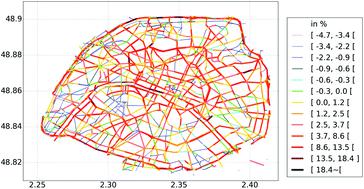当前位置:
X-MOL 学术
›
Faraday Discuss.
›
论文详情
Our official English website, www.x-mol.net, welcomes your
feedback! (Note: you will need to create a separate account there.)
Simulation of primary and secondary particles in the streets of Paris using MUNICH
Faraday Discussions ( IF 3.3 ) Pub Date : 2020-9-9 , DOI: 10.1039/d0fd00092b Lya Lugon 1 , Karine Sartelet , Youngseob Kim , Jéremy Vigneron , Olivier Chrétien
Faraday Discussions ( IF 3.3 ) Pub Date : 2020-9-9 , DOI: 10.1039/d0fd00092b Lya Lugon 1 , Karine Sartelet , Youngseob Kim , Jéremy Vigneron , Olivier Chrétien
Affiliation

|
High particle concentrations are observed in the streets. Regional-scale chemistry-transport models are not able to reproduce these high concentrations, because their spatial resolution is not fine enough. Local-scale models are usually employed to simulate the high concentrations in street networks, but they often adopt substantial simplifications to determine background concentrations and use simplified chemistry. This study presents the new version of the local-scale Model of Urban Network of Intersecting Canyons and Highways (MUNICH) that integrates background concentrations simulated by the regional-scale chemistry-transport model Polair3D, and uses the same complex chemistry module as Polair3D, SSH-aerosol, to represent secondary aerosol formation. Gas and aerosol concentrations in Paris streets are simulated with MUNICH, considering a street-network with more than 3800 street segments, between 3 May and 30 June. Comparisons with PM10 and PM2.5 measurements at several locations of Paris show that the high PM10 and PM2.5 concentrations are well represented. Furthermore, the simulated chemical composition of fine particles corresponds well to a yearly measured composition. To understand the influence of the secondary pollutant formation, several sensitivity simulations are conducted. Simulations with and without gas-phase chemistry show that the influence of gas-phase chemistry on the formation of NO2 is large (37% on average over May and across all modelled streets), but the influence on condensables is lower (less than 2% to 3% on average at noon for inorganics and organics), but may reach more than 20% depending on the street. The assumption used to compute gas/particle mass transfer by condensation/evaporation is important for inorganic and organic compounds of particles, as using the thermodynamic equilibrium assumption leads to an overestimation of the organic concentrations by 4.7% on average (up to 31% at noon depending on the streets). Ammonia emissions from traffic lead to an increase in inorganic concentrations by 3% on average, reaching 26% depending on the street segments. Not taking into account gas-phase chemistry and aerosol dynamics in the modelling leads to an underestimation of organic concentrations by about 11% on average over the streets and time, but this underestimation may reach 51% depending on the streets and the time of the day.
中文翻译:

使用MUNICH模拟巴黎街道上的初级和次级粒子
在街道上观察到较高的颗粒浓度。区域规模的化学运输模型无法重现这些高浓度,因为它们的空间分辨率不够精细。通常使用局部模型来模拟街道网络中的高浓度,但是它们通常采用实质性简化来确定背景浓度并使用简化的化学方法。这项研究提出了新版本的相交峡谷和公路城市网络局部模型(MUNICH),该模型整合了区域规模化学运输模型Polair3D模拟的背景浓度,并使用了与Polair3D,SSH相同的复杂化学模块-气溶胶,代表二次气溶胶的形成。使用MUNICH模拟巴黎街道上的气体和气溶胶浓度,考虑在5月3日至6月30日之间拥有3800多个路段的街道网络。与PM的比较在巴黎几个地点进行的10和PM 2.5测量表明,高浓度的PM 10和PM 2.5可以很好地体现出来。此外,细颗粒的模拟化学成分很好地对应于年度测量的成分。为了了解次级污染物形成的影响,进行了几种灵敏度模拟。有或没有气相化学反应的模拟表明,气相化学反应对NO 2形成的影响很大(五月份和所有模拟街道上的平均比例为37%),但对可冷凝物的影响较小(无机和有机物在中午平均低于2%至3%),但根据不同情况可能会超过20%街道。用于计算通过冷凝/蒸发进行的气体/颗粒传质的假设对于颗粒的无机和有机化合物非常重要,因为使用热力学平衡假设会导致有机浓度平均高估4.7%(中午时高达31%)取决于街道)。交通产生的氨气排放导致无机物浓度平均增加3%,根据街道段的不同,达到26%。
更新日期:2020-09-09
中文翻译:

使用MUNICH模拟巴黎街道上的初级和次级粒子
在街道上观察到较高的颗粒浓度。区域规模的化学运输模型无法重现这些高浓度,因为它们的空间分辨率不够精细。通常使用局部模型来模拟街道网络中的高浓度,但是它们通常采用实质性简化来确定背景浓度并使用简化的化学方法。这项研究提出了新版本的相交峡谷和公路城市网络局部模型(MUNICH),该模型整合了区域规模化学运输模型Polair3D模拟的背景浓度,并使用了与Polair3D,SSH相同的复杂化学模块-气溶胶,代表二次气溶胶的形成。使用MUNICH模拟巴黎街道上的气体和气溶胶浓度,考虑在5月3日至6月30日之间拥有3800多个路段的街道网络。与PM的比较在巴黎几个地点进行的10和PM 2.5测量表明,高浓度的PM 10和PM 2.5可以很好地体现出来。此外,细颗粒的模拟化学成分很好地对应于年度测量的成分。为了了解次级污染物形成的影响,进行了几种灵敏度模拟。有或没有气相化学反应的模拟表明,气相化学反应对NO 2形成的影响很大(五月份和所有模拟街道上的平均比例为37%),但对可冷凝物的影响较小(无机和有机物在中午平均低于2%至3%),但根据不同情况可能会超过20%街道。用于计算通过冷凝/蒸发进行的气体/颗粒传质的假设对于颗粒的无机和有机化合物非常重要,因为使用热力学平衡假设会导致有机浓度平均高估4.7%(中午时高达31%)取决于街道)。交通产生的氨气排放导致无机物浓度平均增加3%,根据街道段的不同,达到26%。











































 京公网安备 11010802027423号
京公网安备 11010802027423号